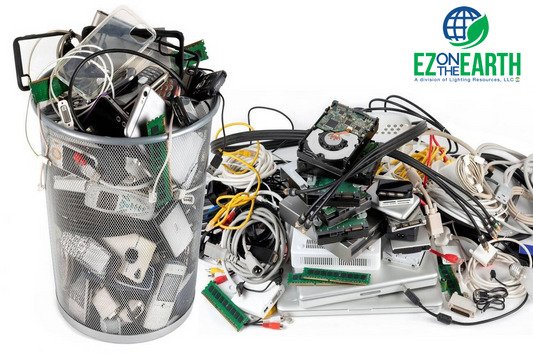
Electronic waste, or e-waste, refers to discarded electrical and electronic devices such as computers, smartphones, televisions, and household appliances. As technology continues to advance at a rapid pace, the volume of e-waste is growing exponentially, posing significant environmental and health risks. Proper Electronic Waste Recycling is critical to mitigating these impacts, recovering valuable materials, and promoting a sustainable future.
The Growing Problem of E-Waste
E-Waste Statistics
Globally, millions of tons of e-waste are generated annually. According to recent studies, approximately 53.6 million metric tons of e-waste were produced worldwide in 2019, with this figure expected to increase to over 74 million metric tons by 2030.
Causes of E-Waste Growth
- Technological Advancements: Rapid innovation leads to frequent device upgrades, rendering older models obsolete.
- Consumer Behavior: A culture of consumption and short product lifecycles contributes to increased electronic waste.
- Inadequate Recycling Infrastructure: In many regions, lack of access to proper recycling facilities exacerbates the problem.
Environmental and Health Impacts
Improper disposal of e-waste, such as dumping in landfills or incineration, releases harmful toxins like lead, mercury, and cadmium into the environment. These substances can contaminate soil, water, and air, posing severe health risks, including respiratory problems, neurological damage, and cancer.
What Is Electronic Waste Recycling?
Electronic waste recycling involves recovering valuable materials from discarded electronic devices and safely disposing of hazardous components. Recycling transforms e-waste into reusable resources, reducing environmental pollution and conserving natural resources.
Benefits of E-Waste Recycling
Environmental Protection
- Reduction in Landfill Waste: Recycling minimizes the volume of e-waste sent to landfills, reducing environmental contamination.
- Prevention of Toxic Leaks: Safe recycling prevents harmful chemicals from leaking into the soil and water.
- Lower Carbon Footprint: Recycling reduces the need for raw material extraction, decreasing energy consumption and greenhouse gas emissions.
Resource Recovery
Electronic devices contain valuable materials like gold, silver, copper, and rare earth elements. Recycling allows these materials to be recovered and reused in manufacturing, reducing the demand for mining and preserving finite natural resources.
Economic Benefits
The e-waste recycling industry creates jobs and contributes to the economy by generating raw materials for the electronics sector. Additionally, refurbished devices provide affordable options for consumers.
Compliance with Regulations
Recycling helps businesses and individuals comply with environmental regulations, avoiding fines and legal penalties.
The E-Waste Recycling Process
Step 1: Collection
E-waste is collected from households, businesses, and institutions through drop-off centers, collection drives, and take-back programs offered by manufacturers.
Step 2: Sorting and Inspection
Collected e-waste is sorted based on device type, material composition, and condition. Functional devices may be refurbished, while damaged items proceed to recycling.
Step 3: Dismantling
Devices are dismantled to separate components like circuit boards, batteries, screens, and plastics. Manual dismantling allows for precise sorting of hazardous and valuable materials.
Step 4: Material Recovery
- Shredding: E-waste is shredded into smaller pieces for easier processing.
- Separation: Advanced techniques, such as magnetic separation and eddy current separation, are used to isolate metals, plastics, and other materials.
- Extraction: Precious metals are extracted using chemical or mechanical processes.
Step 5: Safe Disposal of Non-Recyclables
Non-recyclable components, such as certain plastics and hazardous materials, are safely treated and disposed of in compliance with environmental regulations.
Challenges in E-Waste Recycling
Informal Recycling Practices
In many developing countries, informal recycling operations dominate the e-waste sector. These unregulated activities often involve unsafe methods like burning or acid leaching, exposing workers and the environment to toxic substances.
Lack of Awareness
Many consumers are unaware of the importance of e-waste recycling or how to access recycling services, leading to improper disposal.
Complexity of Devices
Modern electronic devices are complex, containing a mix of materials that are difficult to separate and recycle efficiently.
High Costs
The cost of setting up and maintaining recycling facilities can be a barrier, especially in low-income regions.
E-Waste Recycling Regulations and Initiatives
Global Efforts
- The Basel Convention: This international treaty regulates the transboundary movement of hazardous waste, including e-waste, to prevent environmental harm.
- The Stockholm Convention: Focused on reducing persistent organic pollutants (POPs) found in e-waste, such as certain flame retardants.
Regional and National Regulations
- Extended Producer Responsibility (EPR): Many countries mandate that manufacturers take responsibility for the end-of-life management of their products.
- EU WEEE Directive: The European Union’s Waste Electrical and Electronic Equipment (WEEE) Directive requires member states to set e-waste recycling targets.
- EPA Guidelines in the USA: The Environmental Protection Agency (EPA) provides guidelines for e-waste recycling and promotes responsible disposal practices.
How to Participate in E-Waste Recycling
For Individuals
- Use Recycling Programs: Take advantage of manufacturer take-back programs and local recycling centers.
- Donate Functional Devices: Consider donating working electronics to charities or schools.
- Avoid Hoarding: Regularly dispose of unused electronics to prevent clutter and environmental harm.
For Businesses
- Partner with Certified Recyclers: Work with certified e-waste recyclers to ensure safe disposal of obsolete equipment.
- Implement Recycling Policies: Encourage employees to recycle electronics through workplace programs.
- Support Sustainable Procurement: Invest in energy-efficient and recyclable devices.
The Future of Electronic Waste Recycling
Technological Innovations
Advances in recycling technology, such as robotic disassembly and improved material separation methods, are making the process more efficient and cost-effective.
Circular Economy Models
The shift toward circular economy models emphasizes designing products for longevity, repairability, and recyclability, reducing e-waste generation.
Increased Awareness
Educational campaigns and community outreach programs are raising awareness about the importance of e-waste recycling and encouraging widespread participation.
Conclusion
Electronic waste recycling is a critical component of sustainable waste management, addressing the environmental and health challenges posed by discarded electronics. By recovering valuable resources, reducing pollution, and creating economic opportunities, e-waste recycling contributes to a cleaner and greener planet. With the collective efforts of individuals, businesses, and governments, we can turn the growing e-waste problem into an opportunity for innovation and sustainability.



